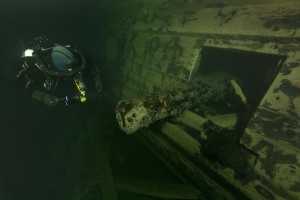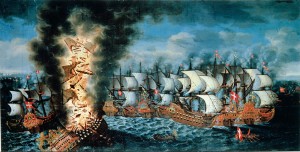 Deep Sea Productions divers have discovered what they believe to be the wreck of the 17th century Swedish royal warship Svärdet, or “Sword” in English. The 82-foot ship was found on the seafloor between 160 and 320 feet deep off the coast of the island of Öland, not far from where the wreck of the 16th century Swedish warship Mars was discovered earlier this year.
Deep Sea Productions divers have discovered what they believe to be the wreck of the 17th century Swedish royal warship Svärdet, or “Sword” in English. The 82-foot ship was found on the seafloor between 160 and 320 feet deep off the coast of the island of Öland, not far from where the wreck of the 16th century Swedish warship Mars was discovered earlier this year.
Built in 1642, the Svärdet sank with near-legendary drama during the Battle of Öland on June 1, 1676, along with its sister-ship the Kronan, or “The Crown.” Built in the 1670s, the Kronan was the flagship of the Swedish fleet, one of the world’s largest seagoing vessels and one of its most heavily armed. Both it and Svärdet were richly decorated in a style known as a “gaudy” ship, designed to intimidate the enemy with size and fanciness. It didn’t work in this case.
When Admiral of the Realm Lorentz Creutz, the Kronan‘s commander, ordered the ship to turn hard south with open gunports and too much sail, the ship flooded and capsized. Then for a reason never fully explained the gunpowder magazine exploded, taking most of the bow with it and the ship sank taking over 800 men with her, including Creutz, other high-ranking naval officers and the navy’s chief doctor.
 Taking advantage of the confusion caused by the Kronan‘s sudden implosion, the allied Dano-Norwegian-Dutch fleet surrounded the Svärdet, attacking it on all sides. Its commander, Admiral Claes Uggla, held off the four attacking vessels, including the flagships of the Danish and Dutch fleets, for two hours. Finally Svärdet lost its mainmast and was pierced below the waterline. Uggla refused to surrender, even after they were hit by a fireship which did its duty and infected the Svärdet with its flames. He and his entire company went down with the ship.
Taking advantage of the confusion caused by the Kronan‘s sudden implosion, the allied Dano-Norwegian-Dutch fleet surrounded the Svärdet, attacking it on all sides. Its commander, Admiral Claes Uggla, held off the four attacking vessels, including the flagships of the Danish and Dutch fleets, for two hours. Finally Svärdet lost its mainmast and was pierced below the waterline. Uggla refused to surrender, even after they were hit by a fireship which did its duty and infected the Svärdet with its flames. He and his entire company went down with the ship.
The Battle of Öland is the largest naval battle the Baltic has ever seen. The wreck of the Kronan was rediscovered in August of 1980 after decades of searching by a team headed by Anders Franzén, the marine engineer and amateur historian who had found the Vasa in 1956. Finally finding its sister is therefore enormously exciting.
Malcolm Dixelius, head of Deep Sea Productions, is cagey on its exact location. It was not discovered in Swedish waters, so Swedish conservation law does not apply.
“The Baltic Sea is very complicated… Different countries interpret the laws in different ways,” he said.
“What is important is that we know where it is and we will help scientists to investigate it. We are working with colleagues who found the Mars, since these two ships are fairly close to each other and have a common history,” he added.
The Mars sank in 1564 and was found last spring. Both the Mars and Svärdet “are untouched,” Dixelius said.
“No one has been on them. Both the Vasa and Kronan were stripped in the 1600s. Here all the cannons are still there. They probably knew in the 1600-1700s where these wrecks were, but couldn’t get at them, because they were so deep,” he said.
The Baltic is a shipwreck lover’s dream. Its low temperatures and low salt levels act as excellent preservatives and make the environment extremely inhospitable to critters who enjoy eating wood, like shipworm. You can see the remarkable condition the ship is in in this footage of the wreck:
Wow. In the last two minutes of the clip, you can see what appears to be the still-knotted remnant of some sort of rope or cord netting (unless that’s something the discoverers laid over). It’s pretty amazing that something like that would remain for so long, getting on 340 years, low temp and salt regardless.
Haunting too, to see the places where they wood had burned before the ship went under. And one of those cannons looked pretty yellow; made of still unoxidized brass, I would guess.
:yes: Thats right and worth a fotune
The ropes and netting you see is most likely fishing nets that got hooked on the wreck at some point. This is common on most wrecks.